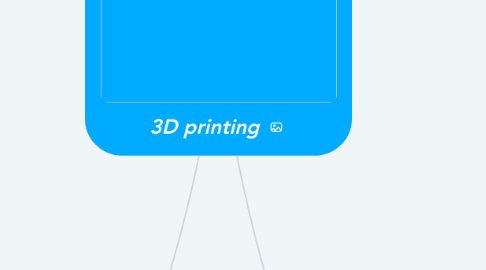
1. background
1.1. history
1.1.1. 1st 3D printer:1984 (by Charles Hull)
1.1.1.1. named as stereo lithograpgy
1.1.1.2. obtained patent for the technique(1986)
1.1.2. 1st 3D printer built by 3D system:1992
1.1.3. 1st application of 3D printing in medical field:1999
1.1.3.1. human bladder
1.1.4. HD color 3D printer:2005(Z Corp)
1.2. name
1.2.1. also known as Addicitive Manufacturing
2. Application
2.1. Future
2.1.1. print a replacement for lost items(eg. battery cover/remote)
2.1.2. print out organs for humans(eg. reconstructing bones/body parts)
2.1.2.1. 1st printed organ: tiny replicas of human liver( at Organovo in San Deigo)
2.1.3. Building contructions
2.1.4. aircraft wings
2.1.5. reconstructing fossils
2.1.6. making food in space
2.1.6.1. researched by NASA
2.1.7. .......endless
2.2. Present
2.2.1. Industrial
2.2.1.1. rapid prototyping
2.2.1.2. rapid manufacturing
2.2.1.3. rapid customization
2.2.1.4. mass production
2.2.2. Domestic (Window 8 operating system)
2.2.2.1. cloting
2.2.2.2. Accessories:jewelery
2.2.2.3. Entertainment & Toys
2.2.3. Medical
2.2.3.1. bio-printing
2.2.3.2. implant & medical device
2.2.3.3. artificial arms for disabled
2.2.3.4. secrets of hearts
2.2.3.5. bionic ears
3. What is it?
3.1. working
3.1.1. materials
3.1.1.1. printing materials
3.1.1.1.1. plastic filament
3.1.1.1.2. metals
3.1.1.2. 3D printer
3.1.1.3. software
3.1.1.3.1. Auto CAD
3.1.1.3.2. 3dsMax
3.1.1.3.3. Blender
3.1.1.3.4. SketchUp
3.1.2. principle
3.1.2.1. modeling
3.1.2.1.1. CAD file is created
3.1.2.1.2. sliced them into digital cross-sections
3.1.2.2. Printing
3.1.2.2.1. (.STL/.VRML file)exported to a 3D printing machine
3.1.2.2.2. lays down successive layers of materials
3.1.2.3. Finishing
3.1.2.3.1. actual object formed
3.1.3. methods
3.1.3.1. selective laser sintering (SLS)
3.1.3.1.1. using high power laser
3.1.3.2. stereo lithography (SL)
3.1.3.2.1. using a vat of liquid UV-curable photopolymer & UV laser
3.1.3.3. fused deposition modeling (FDM)-->most common
3.1.3.3.1. melt plastic on a platform
3.1.3.4. Others
3.1.3.4.1. poly-jet photopolymer
3.1.3.4.2. syringe extrusion
3.1.3.4.3. Digital Light Processing
3.1.3.4.4. Electron Beam Melting
3.2. Advantages
3.2.1. rapid prototyping
3.2.2. clean process
3.2.3. complex shape can be produced
3.2.4. easy to use
3.2.5. reduce design complexity
3.2.6. no storage cost
3.2.7. low production cost
3.2.8. quick availability of organs
3.3. Disadvantages
3.3.1. slow process
3.3.2. high cost of 3D printer & raw materials
3.3.3. misuse of technology/create illegal products (eg. guns)
3.3.4. unchecked production of dangerous items
3.3.5. intellectual property issues
3.3.6. limitations of size
3.3.7. limitations of raw materials

